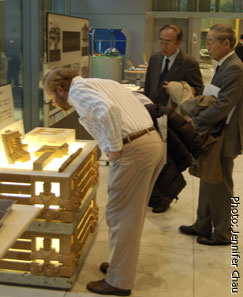Frank Lloyd Wright and Building Preservation in Japan: Reconsidering the Imperial Hotel's Impact 40 Years On
Some 150 people were in attendance on Dec. 3, 2007 for WAAJ's daylong international symposium. Co-organized with the American Institute of Architects, Japan Chapter, the symposium commemorated the closure 40 years ago of the original Imperial Hotel, designed by Frank Lloyd Wright.
The Wright Imperial's demise in December 1967 was a watershed event in landmark building preservation in Japan, marking the end of rescue
efforts that had rallied thousands of supporters around the world, but also contributing to a new awareness of the importance of preservation. Over
the past 40 years, there have been triumphs—such as the saving of Wright's Jiyu Gakuen Myonichikan in Mejiro, Tokyo—and there have been losses. This
anniversary provided a timely opportunity to reconsider the impact of the Imperial Hotel by sharing a rich range of preservation experiences
related to Wright and his Japanese followers, and from them, drawing inspiration and optimism for the future of Japan’s modern architectural legacy.
Renowned University of Tokyo architectural historian Hiroyuki Suzuki was the keynote speaker for Part I of the symposium, entitled The Imperial Hotel as Catalyst for Japan's Preservation Movement. Dr. Suzuki's discussion of how Wright had impacted Japanese architecture and preservation was followed by a unique presentation from three of the men who exhaustively measured the Imperial Hotel in 1967, when they were students at Waseda University: Takeya Arakawa, Akihiko Asami and Yoshito Shima. It was the first time they had ever spoken publicly about their important contribution to architectural history, which was published with photographs in book form in 1972 as Frank Lloyd Wright in Imperial Hotel.
Part II of the symposium, entitled Forging New Pathways to Preservation with the Tools of Past Successes, featured individual presentations from an international panel of architects and preservation experts, followed by an animated discussion moderated by Koichiro Kanematsu, Secretary-General of DoCoMoMo Japan. After Mr. Kanematsu had kicked off the session, WAAJ Vice Chairman Tetsuya Minamiseko, Architect and Prof. Emeritus, Kogakuin University, spoke about the process of preserving the Myonichikan. He was followed by leading U.S. preservationist Cherilyn Widell, who spoke on the necessity of building “villages” to save Wright (and other historic) properties. Prof. David Stewart, an architectural historian from the Tokyo Institute of Technology, provided an overview of the preservation cultures in the U.S. and Japan. Hideko Matsunami, Chief Research Architect at the Shimizu Institute of Technology, discussed new techniques for restoring buildings in Japan.
There were also special case study presentations highlighting two Wright-designed homes in the U.S. and university buildings designed by Wright apprentice Antonin Raymond in Japan. Gary Ditmer, owner of Wright's Schwartz House (Two Rivers, WI), and Michael Crittendon of Steelcase, owner of Wright's May House (Grand Rapids, MI), described the processes that went into renovating the two homes and how they are now being used. Fusako Fujiwara, Chair of the Committee to Preserve Raymond’s Architecture at Tokyo Woman’s Christian University, provided an overview of the ongoing preservation campaign.
The event, held in the spacious Shinsei Hall in Uchisaiwaicho, also featured a mini-exhibition, with a recreated light podium and decorative tiles from Inax, a display of historical photos and drawings related to the Imperial Hotel, a model and drawings of the Jiyu Gakuen Myonichikan, and DVDs on the Imperial Hotel and Inax's recreation of Imperial tiles, the Meyer May House and the Bernard Schwartz House.
Reconsidering the Imperial Hotel's Impact 40 Years On was sponsored by Best, Imperial Hotel, Inax, Kokuyo Furniture, Obayashi, Sweden House, Takenaka and Usonian 21. It was supported by the the Agency for Cultural Affairs, the Architectural Institute of Japan, DoCoMoMo Japan, The Frank Lloyd Wright Foundation, the Japan Association of Architectural Firms, the Japan Institute of Architects and the U.S. Embassy of Japan. The event space was kindly provided by Shinsei Bank, Ltd.


